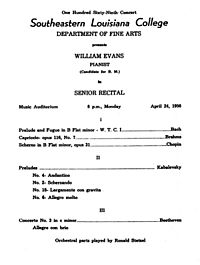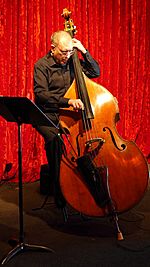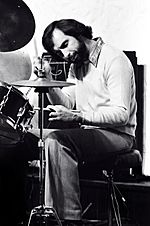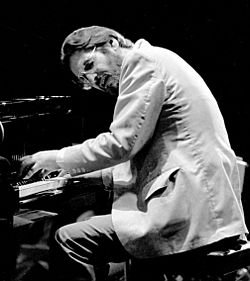Bill Evans facts for kids
Quick facts for kids
Bill Evans
|
|
|---|---|
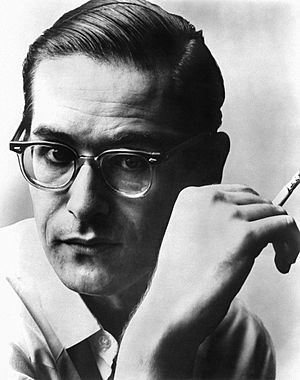
Evans in 1961
|
|
| Background information | |
| Birth name | William John Evans |
| Born | August 16, 1929 Plainfield, New Jersey, U.S. |
| Died | September 15, 1980 (aged 51) New York City, U.S. |
| Genres |
|
| Occupation(s) |
|
| Instruments | Piano |
| Years active | 1950s–1980 |
| Labels |
|
| Associated acts | George Russell, Miles Davis, Cannonball Adderley, Philly Joe Jones, Scott LaFaro, Paul Motian, Eddie Gómez, Marty Morell, Tony Bennett, Jim Hall, Stan Getz, Monica Zetterlund, Chet Baker |
William John Evans (born August 16, 1929 – died September 15, 1980) was an American jazz pianist and composer. He was best known for leading his own jazz trio. Bill Evans used special harmonies and played melodies that sounded like they were singing. His unique style still inspires many jazz pianists today.
He was born in Plainfield, New Jersey, U.S. He studied classical music at Southeastern Louisiana University and the Mannes School of Music in New York City. In 1955, he moved to New York and worked with bandleader George Russell. In 1958, Evans joined Miles Davis's famous band. In 1959, they recorded Kind of Blue, which is one of the best-selling jazz albums ever.
In late 1959, Evans started his own trio. It included bassist Scott LaFaro and drummer Paul Motian. This group is now seen as one of the most important modern jazz trios. In 1961, they recorded two live albums at New York's Village Vanguard jazz club: Sunday at the Village Vanguard and Waltz for Debby. Sadly, ten days after these recordings, LaFaro died in a car accident. After a break, Evans formed a new trio with bassist Chuck Israels.
In 1963, Evans recorded Conversations with Myself. This solo album used a special recording technique called overdubbing. This meant he could record multiple piano parts and layer them together. In 1966, he started working with bassist Eddie Gómez, and they played together for 11 years. In the mid-1970s, Bill Evans also worked with singer Tony Bennett. They made two popular albums: The Tony Bennett/Bill Evans Album (1975) and Together Again (1977).
Many of Evans's songs, like "Waltz for Debby", are now jazz classics. Other musicians often play and record them. Evans was nominated for 31 Grammy Awards and won seven. He was also added to the DownBeat Jazz Hall of Fame.
Contents
The Life of Bill Evans
Early Years and Music
Bill Evans grew up in North Plainfield, New Jersey. His parents were Harry and Mary Evans. He had an older brother named Harry, and they were very close.
Bill started piano lessons when he was young, around age six or seven. He quickly learned to read music well. His teacher, Helen Leland, focused on playing music freely, not just on strict rules. When he was seven, Bill also started violin and flute lessons. He later stopped these, but they might have helped his piano playing style. He loved music by classical composers like Mozart and Beethoven.
Around age 12, Bill first heard jazz music on the radio. He listened to bands like Tommy Dorsey and Harry James. When he was 13, he started playing piano for dances and weddings. He earned about $1 an hour. He also met other musicians who influenced him, like bassist George Platt, who taught him about music theory. Bill also listened to jazz greats like Nat King Cole. He graduated from North Plainfield High School in 1946.
College and Army Service
In September 1946, Evans went to Southeastern Louisiana University. He had a scholarship to study flute, but he also studied classical piano. He composed his first known song, "Very Early," during his third year of college. He also created a piece called "Peace Piece." In 1950, he graduated with degrees in piano and music education. Bill said his last three years in college were the happiest of his life.
After college, Evans moved to New York City with guitarist Mundell Lowe and bassist Red Mitchell. They formed a trio but struggled to find gigs. In July 1950, Evans joined Herbie Fields's band in Chicago. They toured with singer Billie Holiday. Soon after, Evans joined the U.S. Army.
During his three years in the Army (1951–1954), Evans played flute, piccolo, and piano in the Fifth U.S. Army Band. He also hosted a jazz radio show at the camp. Around 1953, Evans wrote his most famous song, "Waltz for Debby," for his young niece. After leaving the Army in 1954, Evans took a year off. He practiced piano at his parents' house, working on his playing skills.
Back to New York City
In July 1955, Evans returned to New York City. He studied music composition at the Mannes College of Music. He also played piano at various events, like weddings and dances. He even played solo at the Village Vanguard, where Miles Davis once listened to him. During this time, he met other jazz legends like Thelonious Monk.
Evans began playing in clubs with musicians like Don Elliott and Tony Scott. He also recorded with singer Lucy Reed. Through Reed, he met Helen Keane, who later became his manager. He also worked with George Russell, a composer who developed new ideas about music theory.
First Album: New Jazz Conceptions
In September 1956, producer Orrin Keepnews decided to record Evans. This led to his first album, New Jazz Conceptions. It included early versions of "Waltz for Debby" and "Five." This album started Evans's connection with Riverside Records. It also formed his first trio with Teddy Kotick on bass and Paul Motian on drums.
Critics liked the album, but it didn't sell many copies at first. After the album, Evans spent a lot of time studying the music of J. S. Bach. He believed this helped him improve his piano technique.
Working with George Russell
Evans met composer George Russell through Lucy Reed. Russell was creating a new music theory called the Lydian Chromatic Concept of Tonal Organization. This theory suggested new ways to think about musical scales and keys. Evans, who already knew some of these ideas, started working with Russell in 1956.
Russell included Evans on his album The Jazz Workshop (1957). Evans played an important solo in a piece called "Concerto for Billy the Kid." In 1957, Russell also wrote a piece called "All About Rosie" for a festival. Evans was a featured soloist, and his performance was highly praised.
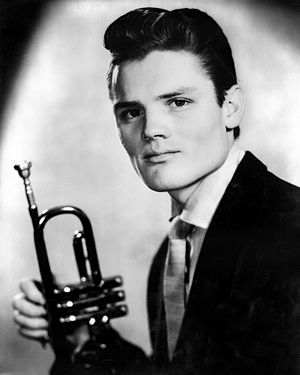
That year, Evans also met bassist Scott LaFaro. He was very impressed by LaFaro's playing. LaFaro would later join Evans's trio. Evans also played on albums by other famous musicians like Charles Mingus and Art Farmer.
Miles Davis and Kind of Blue
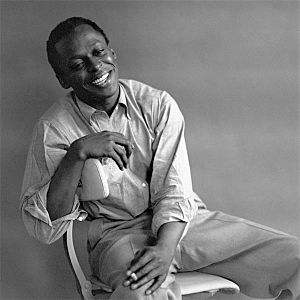
In February 1958, Miles Davis invited Evans to play with his band. At the time, Davis's band included John Coltrane and Cannonball Adderley. Evans joined the group in April 1958. Davis was exploring a new style called modal jazz. This style used musical modes (types of scales) instead of many chord changes. Evans, with his knowledge of Russell's theories, was perfect for this new sound.
Evans also introduced Davis to classical composers like Sergei Rachmaninoff. The band's sound became smoother with Evans. In July 1958, Evans played on Cannonball Adderley's album Portrait of Cannonball. This album featured "Nardis," a song written by Davis that later became a favorite for Evans's own trios.
By late 1958, Evans decided to leave Davis's band. He felt his playing had improved greatly. In December, Evans recorded his second trio album, Everybody Digs Bill Evans, with bassist Sam Jones and drummer Philly Joe Jones.
One special song on the album was "Peace Piece." Evans started playing an introduction and just kept improvising. It became a beautiful, flowing piece.
Evans returned to Miles Davis's band in early 1959 to record Kind of Blue. This album is considered one of the most important jazz albums ever. For Kind of Blue, Davis gave the musicians only basic ideas and scales. They had to improvise most of the music. Evans helped write "Blue in Green," though it was first credited only to Davis. Evans also wrote the liner notes for the album, comparing jazz improvisation to Japanese visual art.
Bill Evans's Famous Trios
Bill Evans was known for his piano trios. He played with many talented bassists and drummers over the years.

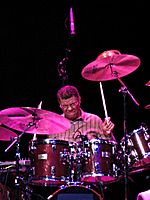
The Trio with Scott LaFaro and Paul Motian
In mid-1959, Evans formed a new trio with bassist Scott LaFaro and drummer Paul Motian. This group became one of the most famous piano trios in jazz history. They focused on playing jazz standards and Evans's own songs. The musicians listened closely to each other, creating a very connected sound. In December 1959, they recorded their first album, Portrait in Jazz.
In February 1961, this trio recorded their second and last studio album, Explorations. It included their version of "Nardis." In late June 1961, they recorded live at the Village Vanguard. These recordings became the albums Sunday at the Village Vanguard and Waltz for Debby. Evans was very happy with these recordings, feeling they showed the trio's best musical connection.
After LaFaro's Passing
The sudden death of Scott LaFaro in a car accident deeply affected Evans. He stopped recording and performing for several months.
In October 1961, Evans returned to music. He formed a new trio with bassist Chuck Israels. In April and May 1962, Evans recorded a duo album, Undercurrent, with guitarist Jim Hall.
In 1963, Evans recorded Conversations with Myself. This album used a technique called overdubbing, where he recorded up to three piano parts for each song. This album won him his first Grammy Award.
Bill Evans and Eddie Gómez
In 1966, Bill Evans met bassist Eddie Gómez. Gómez stayed with Evans's trio for eleven years, bringing new energy to the group. One important album from this time is Bill Evans at the Montreux Jazz Festival (1968), which won Evans his second Grammy. This album also featured drummer Jack DeJohnette.
Other notable recordings from this period include Alone (1968), a solo piano album that won his third Grammy. In 1968, drummer Marty Morell joined the trio. This group stayed together until 1975, making it Evans's longest-lasting trio.
Between 1969 and 1970, Evans recorded From Left to Right, where he first used an electric piano. In 1971, The Bill Evans Album won two Grammy awards. This album featured all original songs and used both acoustic and electric piano.
Working with Tony Bennett
In the mid-1970s, Bill Evans worked with the famous singer Tony Bennett. They made two highly praised albums: The Tony Bennett/Bill Evans Album (1975) and Together Again (1977).
Tony Bennett wanted to work with Bill Evans because they both respected each other's musical skills. They performed concerts together for about two years. Both musicians said it was a true partnership, not just a singer with an accompanist. Evans's complex piano arrangements and solos were encouraged by Bennett. This showed that both musicians were equally important to the music.
Final Years
In 1975, drummer Eliot Zigmund joined Evans's trio. They recorded I Will Say Goodbye and You Must Believe in Spring. These albums showed new ideas in group playing and harmony.
In 1978, Gómez and Zigmund left. Evans then formed his last trio with Marc Johnson on bass and Joe LaBarbera on drums. In August 1979, Evans recorded his last studio album, We Will Meet Again. It included a song written for his brother, who had passed away the year before. This album won a Grammy award after his death in 1981.
Bill Evans's Music Style
Bill Evans changed the way jazz piano was played. His harmonies were influenced by classical composers like Claude Debussy and Maurice Ravel.
When he played jazz songs, he often changed the chords in new ways. He used special chords with extra notes and unexpected chord changes. One unique thing Evans did was often leave out the lowest note (the root) in his chords. He let the bassist play that note or just let it be implied. This allowed his left hand to create a flowing, continuous sound in the middle part of the piano.
Evans's improvisations often built on small musical ideas, repeating and changing them to create new melodies. He sometimes played different rhythms with each hand, like one hand in 4/4 time and the other briefly in 3/4 time.
He also loved the music of Bach. Bach's music helped Evans improve his piano touch and finger independence. Evans believed that playing Bach correctly helped him develop a special "weight technique" for the piano.
Musical Influences
Bill Evans said that Bud Powell was his biggest influence as a pianist.
Views on Music Trends
Evans's career started just before rock music became very popular in the 1960s. Even as jazz became less mainstream, Evans always found opportunities to play and record.
Evans preferred to stick to his own style and did not embrace new music trends like jazz fusion. He felt that some changes in jazz were due to business reasons, not artistic ones. He believed that electronic music, like the Fender-Rhodes piano, was fun to use sometimes, but he always returned to the acoustic piano. He felt that acoustic instruments had a special sound that electronic ones could not match.
Personal Life
Bill Evans loved to read, especially philosophy and funny books. He enjoyed works by thinkers like Plato and Freud. He was also interested in Eastern religions and philosophies like Zen and Buddhism. He even introduced John Coltrane to the ideas of Krishnamurti.
Evans also liked to paint and draw. He was a big fan of golf, a hobby he started on his father's golf course. He also enjoyed horse racing and sometimes gambled on races. In his later years, he even owned a racehorse with producer Jack Rollins.
Legacy and Influence
Bill Evans has inspired many famous musicians, including Herbie Hancock, Chick Corea, Keith Jarrett, and Diana Krall. His unique piano style and harmonies have left a lasting mark on jazz.
Many of his songs, like "Waltz for Debby", "Turn Out the Stars", and "Very Early", are now jazz standards. Musicians around the world play and record them often.
During his life, Evans received 31 Grammy nominations and won seven awards. In 1994, he was given the Grammy Lifetime Achievement Award after his death.
Southeastern Louisiana University, where Evans studied, holds the Bill Evans archives. They also have a Bill Evans Jazz Festival that started in 2002. He was named the Outstanding Alumnus of the year in 1969.
List of Compositions
Bill Evans wrote many original songs, often dedicating them to people he cared about. For example, "Waltz for Debby" was for his niece. "For Nenette" was for his wife, and "Letter to Evan" was for his son. He also wrote "Re: Person I Knew," which is an anagram of his friend and producer Orrin Keepnews's name. "We Will Meet Again" was written for his brother.
Tribute Albums
Discography
Images for kids
See also
 In Spanish: Bill Evans (pianista) para niños
In Spanish: Bill Evans (pianista) para niños


